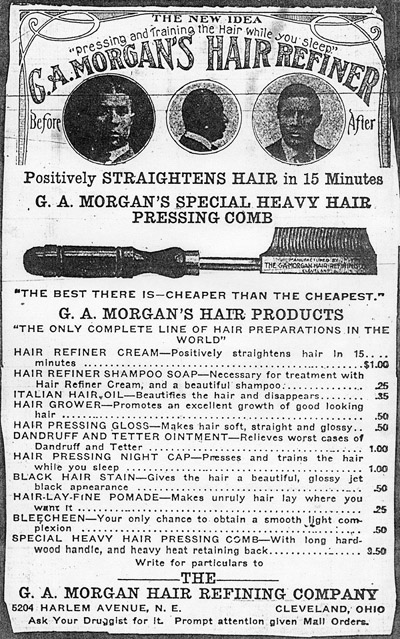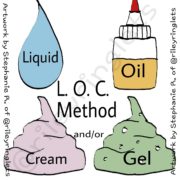What Is Natural Hair Breakage? (And How To STOP It)
Got a ton of hair in your comb or brush, and still wondering if shed hair is normal? It is, but… breakage is different from shedding. Shedding is a normal part of the growth process. If the hair that fell still has the little white bulb at the end, it’s a shed hair. If that little sucker broke off, call an ambulance. This is a breakage emergency!
Well, maybe not that serious. But breaking strands is your hair’s way of telling you something’s not right. Hair breakage is the result of hair damage. And if you’re seeing a hair snapped here, and there, chances are high that your hair is more damaged than you realize. After all, whatever caused the breakage isn’t happening to just one hair.
Unfortunately, a whole lot of hair has been breaking off as part of our collective history. This brings hair breakage close to being part of the black cultural experience.
A Little History Behind Black Hair Breakage

Photo source: https://craiglaurancegidney.files.wordpress.com
One of the first recorded instances of follicular damage in black people was in 1968 (Dermatology Service, Walter Reed Medical Center). The cause was suspected to be the hot, petroleum-laden hair grease that would clog hair follicles when pressing the hair with a hot comb. In 1983, also due to pressing (heat damage), microscopes uncovered bubbles on the surface of hot-combed hair strands. Hot combs were literally frying our hair, and the broken strands were there on the kitchen floor for all to see.

Then hair straightening trends switched to relaxers (chemical damage). Perms dissolve the main strength of hair strands – their protein. Chemical damage is often coupled with the more modern forms of heat damage. Because, of course, to get that hair to swing, the next phase would be to blow dry it, then to flat iron or heat curl it.
 These hair styling practices cause the protective layer of our strands to be compromised. The initial phases of relaxing start out with a healthy cuticle that has all its shingles fully present, laying down nicely and reflecting light for a nice sheen. As time passes, the cuticle and the inner hair shaft become damaged, because hair cuticle shingles are missing, allowing the inner core of the hair shaft to absorb more harsh chemicals and lose moisture.
These hair styling practices cause the protective layer of our strands to be compromised. The initial phases of relaxing start out with a healthy cuticle that has all its shingles fully present, laying down nicely and reflecting light for a nice sheen. As time passes, the cuticle and the inner hair shaft become damaged, because hair cuticle shingles are missing, allowing the inner core of the hair shaft to absorb more harsh chemicals and lose moisture.
Over time,your hair becomes easy to straighten and heat curl, but this is due to severe damage. Basically, your hair has given up the struggle to maintain its original state. In the old terminology of hot comb kitchens, the hair is now “trained.” It is also thinned from breakage.
Self-Diagnosing Natural Hair Breakage
Hair breakage is the natural result of over processing and mistreatment. Most of us went natural to avoid the cultural practices that cause hair and scalp damage. So we cut off our damaged strands, or transitioned them out, and beautiful curls and coils started popping up everywhere. We’re all floating around on a cloud of loveliness, then BAM! One day, little half strands start appearing in the tub on wash day.
What happened?! If your natural hair is breaking, it’s time to analyze what might have caused it. So ask yourself when the problem started, then figure out what caused the breakage based on the four types of damage below.
- Mechanical damage. There is some form of excessive manipulation, here, due to the accessories you use, the way you style, detangle, comb, brush, dress and sleep. Anything that comes into contact with your hair and pushes, pulls, gathers or sits against it is manipulating it. Maybe one style is being done too much in your hair, or too tightly? Or maybe you are using the same type of hair accessories all the time? Perhaps a little more patience is needed to detangle properly?
- Chemical damage. Relaxers are the most common form of chemical damage, but it doesn’t stop there. What about hair products that contain harsh chemicals? Maybe your hair can take it. Maybe not. Has a new product entered your routine that could be causing your hair to break?
- Heat damage. Diffusers, dryer hoods/caps, blow dryers, flat irons – using heat regularly, even for naturalistas, increases the risk of breakage.
- Follicle damage. Hair follicles can become damaged due to chemicals or tension. When damaged, hair grows in an already weakened state and breaks much easier than it normally would have. Do you have a care routine for your scalp that cleanses, deep conditions and stimulates it for new, healthy growth? It’s worth it.
How To Prevent Breakage?
The truth is, sometimes we don’t maintain the level of care our hair and scalp actually need. If we did, we’d probably prevent a lot of hair breakage. Here are a few things to be mindful of if you’d like to keep your hair healthy and on your head:
- Protect your hair from friction and tangling at night, i.e., don’t rest your hair directly on a cotton pillowcase. You’ll wake up to parched, breakage-prone hair.
- It’s not a good idea to use cotton headwraps or friction-causing hats without a silk or satin barrier. Otherwise, you’ll have similar results to sleeping on a cotton pillowcase.
- Make sure to cleanse and condition under protective styles like weaves and braids, otherwise, your hair follicles could become clogged and the hair underneath break-ably dry.
- Also, don’t leave a protective style in beyond its expiration date. This causes tangling and matting.
- Don’t do white people stuff! That means staying away from oil stripping shampoos and conditioners, washing your hair like a TV commercial, drying it with a towel like in the movies or always wearing tight buns and ponytails. This rough handling causes breakage.
- Be careful about product ingredients. Whip out your magnifying glass, because some products marketed to naturalistas contain harsh alcohols and follicle clogging petroleum derivatives.
Say you’ve skipped some or all of the above in your hair maintenance routine, and now your hair is breaking off pretty badly. Don’t give up hope! The good news is that breakage can be stopped, or at least slowed down, with henna treatments.
How To STOP Hair Breakage?
Henna isn’t just for dyeing the hair. Henna coats the entire hair shaft and effectively brings a new beginning. But by itself, henna can really dry hair out. So to avoid the inherent dryness of henna add clay powder (your choice) and raw honey with warm water to the mix.
Ever heard the adage that Cleopatra used three main ingredients to maintain her beauty: clay, henna and honey? Well, it’s a teeny bit mythical, because upper strata ancient Egyptians used wigs. Forget the wig cap, girl. They actually shaved their natural hair and were wigging it like many of us are today.
Clay, henna and honey together! Mix the three and you get crazy hydration, thicker strands (if yours are thin and prone to breakage) and cuticle repair! #bhs Click To TweetWigs aside, though, there’s a lot of truth to the myth. Maybe it’s one of those little sayings that were meant to pester women with natural hair until they discovered the secret: clay, henna and honey together! Mix the three and you get crazy hydration, thicker strands (if yours are thin and prone to breakage) and cuticle repair! The cute highlights are a bonus.
Cuticle and repair in the same sentence? In a manner of speaking, yes. The henna coats the entire hair strand, including damaged and missing cuticles. #bhs Click To Tweet
Don’t forget to deep condition afterward though..
Alert! Hair Breakage Can Also Indicate a Form of Alopecia
Sometimes, hair breakage is due to a more serious and complicated issue. If you have a patch of broken hair surrounded by longer hair, and the area is starting to thin, it could be a form of alopecia called central centrifugal cicatricial alopecia (CCCA). The problem here is that damaged and dying hair follicles are producing a weakened form of hair, according to the Department of Dermatology and Cutaneous Surgery, University of Miami.
The recommended Western treatment is corticosteroids and minoxidil, to basically put your hair follicles on production overdrive.
Traditional Indian Medicine, Ayurveda -on the other hand- uses natural kitchen ingredients on the scalp to stimulate the hair follicles better than minoxidil solutions for women. Ginger juice is one, says the Asian Journal of Pharmaceutical and Clinical Research. Here’s what to do.
- Grate ginger finely into a bowl and manually squeeze out the juice.
- Add one part juice to three parts of sesame oil.
- Sesame oil has high levels of copper, which strengthens fragile hair and stimulates follicles similarly to minoxidil (NY Academy of Sciences).
- Massage into the scalp.
- Leave on for two hours (or overnight.)
- Rinse, cleanse and condition.
With this method, your hair will grow out from the follicle stronger (and probably quicker too!) Combined with your monthly henna/clay/honey treatments, you should see more repair and far less breakage.






Ccca is why I’m here can you all please do an article about this